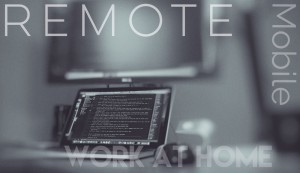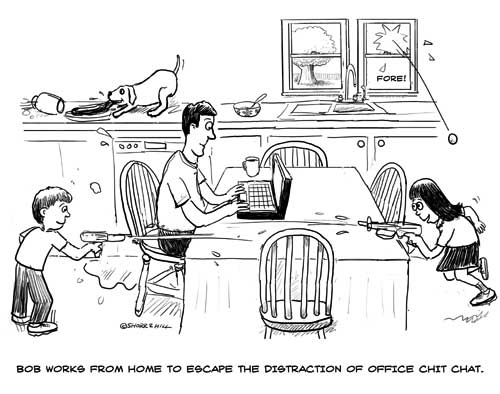All in a day’s work (from home)
 When I read this excellent post from Jason Zimdars on working from home (nodding along in recognition much of the way through), I realized I have now been working from home for almost half of my 21-year career at IBM. A few weeks from now, I will reach my ten year anniversary of leaving the confines (and comforts) of the office environment for the scary and simultaneously freeing experience of having no regular or direct connection to “the office.” I’m not talking about a made-for-TV Michael Scott-esque environment with a crazy but lovable cast of characters. To be honest, many years of my traditional office experiences were pretty mundane: offices with four gray un-windowed walls each day and mediocre cafeteria experiences as notable examples. But there were stretches of my IBM office era that hold great memories of a locally centralized team of developers that worked hard together, enjoyed (sometimes too long) lunches out, played basketball pick-up games (I’m looking at you, Mike Dahmus), had regular foosball and ping-pong breaks, and generally took advantage of all the other bonuses (and distractions) that come from that traditional office environment.
When I read this excellent post from Jason Zimdars on working from home (nodding along in recognition much of the way through), I realized I have now been working from home for almost half of my 21-year career at IBM. A few weeks from now, I will reach my ten year anniversary of leaving the confines (and comforts) of the office environment for the scary and simultaneously freeing experience of having no regular or direct connection to “the office.” I’m not talking about a made-for-TV Michael Scott-esque environment with a crazy but lovable cast of characters. To be honest, many years of my traditional office experiences were pretty mundane: offices with four gray un-windowed walls each day and mediocre cafeteria experiences as notable examples. But there were stretches of my IBM office era that hold great memories of a locally centralized team of developers that worked hard together, enjoyed (sometimes too long) lunches out, played basketball pick-up games (I’m looking at you, Mike Dahmus), had regular foosball and ping-pong breaks, and generally took advantage of all the other bonuses (and distractions) that come from that traditional office environment.
So why and how did I end up at home, and, more importantly, end up liking it enough to stick with it for a decade? And how have I fared against the usual list of concerns regarding remote work? Give me a few minutes and I’ll attempt to provide some gained wisdom from ten years in the home office trenches. But promise me you’ll take the time to read Jason’s post as well, as he does an excellent job of noting why working at home has more value than simply productivity or efficiency enhancements.
Moving Out
My personal story maps closely to Jason’s point about flexibility. My family had a personal desire to move outside the geographic limitations of a local IBM office. At that time, I was the only member of my team located at a particular IBM facility; in fact, most of the team was spread over three or four IBM work locations across every US timezone. In those days, the flexibility to be available for the family at large was a huge benefit, especially during the years when our larger-than-normal family size had a very low average age! The statute of limitations is probably up on some of my “flexible” work schemes so I can share them without repercussion now; it seems ages ago, but there were days when I was going from putting a baby down for a nap in the next room, on to giving an update or presentation to executives and program managers in IBM’s Linux Technology Center. This was “agile” long before agile existed, in my opinion. Little did they know that I had one ear on the call and another on a baby monitor at times! Were there times that this was a potential time conflict with the pressures of my job? Sure, at times it was, and sometimes it was even stressful to juggle these competing worlds. But would I give up those crazy memories with my now fast-growing teenagers? No!
Fast forward ten years and those early work-life flexibility needs aren’t as pressing, but I’m still at home. Why? I find that the interruptions of home life are many times outweighed by the potential interruptions and time sinks of the traditional office environment. As my work life is now busier than ever, the need to fit it all in plus have a home life with busy teenagers, sports, and activities leaves little slack time for investing in commuting, for one major example. While the interruptions in a home environment may be different in nature than the office, the fact that they happen as much (or more) in the traditional office can’t be minimized. The current trend towards open plan work environments has only increased the overall likelihood of regular interruptions. Additionally, it honestly is easier to tell your kids you are busy than that guy who doesn’t get the hint–coming in each morning and proceeding to give you a thirty-minute run down of his evening or weekend activities!
Moving Up
Surely you’ve heard the standard concerns that come up when discussing the remote employee. Concerns like “you’ll be ignored by the on-site team”, “technology challenges with conferencing will hinder your input/participation in discussions”, “you’ll be passed over for promotions and not ‘visible’ enough to leadership”, and so on. Ignoring the technology topic which I’ll mention separately, you obviously do need to remove any practical challenges from not being able to work efficiently based on your specific job role. Don’t move to an area with poor cell coverage if being a mobile employee relying on your mobile device as a primary means of contact is critical for you.
I personally believe a company with a healthy view of remote employees will not overlook or ignore your work output if you’ve enabled yourself to work as hard and as efficiently as you would in the traditional office environment. I have received multiple promotions in the ten years at home, and have moved within the company easily, including taking on new leadership roles as a remote employee. In my personal case, I work for a company that is very comfortable with remote work, and I tend to work on teams with a significant mix of on-site and remote employees. For your situation, it’s worth considering that mix when determining what’s best for you. It goes without saying that if you are the only remote employee, then communication and feeling “in the loop” with the rest of the team may be difficult and, therefore, may require more effort on your part for team education and awareness. However, I personally believe that moving home has had no negative impact on my career growth at IBM. Given my prior comment on interruptions and time commitments for the traditional office, you may find yourself with a leg up on office team members given you may have more actual time in the day to accomplish your work.
Set Up
First let’s cover a few basic ground rules:
- Don’t attempt working remotely if your company does not support it. Perhaps this is painfully obvious, but without a supportive infrastructure for remote work within your company, you are likely doomed to failure. I’m lucky enough to work for a company that has enabled and valued remote employees for longer than I’ve been at home. IBM recently added internal support and discussion forums for mobile and remote employees to connect with others company-wide. Apparently IBM is #7 on the 2016 list of top 100 companies for work at home employees.
- Don’t consider a move to a home office if you aren’t already a self-directed and motivated employee in the traditional office environment. If you can’t focus and accomplish what’s necessary within the strictures of an office environment, moving home is most likely going to exacerbate this pre-existing weakness in your work life.
Without question you will need a consistent and reliable work space based on the needs of your particular job. I personally require very reliable internet service and a good quality work space for the needs of a software development role. The pros: I can provide as nice an environment as I want; in many cases with better equipment and furniture than I would get at a work-provided office. The cons: I pay for it! I personally feel strongly that the home office needs to be a physically separated space, not just a random desk in the living room or den. While I joked that “I pay for it,” you should research and may find that your company will help with certain home office expenses and you can also check into the tax deductibility of your home office.

Copyright (c) Brad Shorr/Mark Hill
Beyond practical set up, get yourself emotionally ready for the different set of environmental challenges and interruptions of the home environment, especially if you have children or others at home during the day with you. As Jason’s post reiterated, these interruptions can and should be welcomed as a benefit to your home experience! Personally one of the biggest lessons I’ve learned in ten years at home is perhaps best termed “grace under fire.” Towards the beginning of my time at home, I found the daily interruptions of life–kids running the halls yelling, babies crying–to be an irritation and annoyance, and honestly, there are still times that this default response comes out. However, the ability to roll with the interruptions has come over time, and I think in hindsight it was a needed and beneficial lesson for me to learn personally. Real life tends to be filled with interruptions and external noise, and the better you can become at working in that context is only an added benefit to your personal development.
Don’t forget to pay attention to your new “co-workers” and their requirements for your at-home work location as well. I promised my wife that when I started working from home I would get dressed for the day and look (reasonably) presentable!
Watch Out
Finally, I will add my voice to the commonly noted caution for the work at home employee: the ease of transition to your work environment can be a temptation never to leave work! “Work hours” can easily expand to anytime day or night. While this can be true for the traditional office employee as well due to the ubiquity of the work VPN and company-issued laptops, it is potentially more pervasive given your default work location is right there within your home 24/7. It takes self-control to make sure that work doesn’t pervade every waking moment through continual returns to “the office” for one last thing.
Several more topics come to mind regarding working at home: things like encouraging continued face to face interactions with others (even if they aren’t your co-workers), handling your workday schedule given new-found flexibility, methods for not hating conference calls, and so on. But, this entry is long enough already and so we’ll save those topics for a future post.
Now let me get showered and shaved for the day; I might have a video call today and need to look human :)
P.S After reading this you might come across a recently published Business Insider story: One of the world’s most important programmers works from home in his bathrobe in complete silence, and assume that it’s about me. Ignoring the fact that the title is quite a mouthful, I’m not into bathrobes and it’s actually a story about Linus Torvalds and his work-at-home setup.




1 Response
[…] https://integratedcode.us/2016/02/23/all-in-a-days-work-from-home/ […]